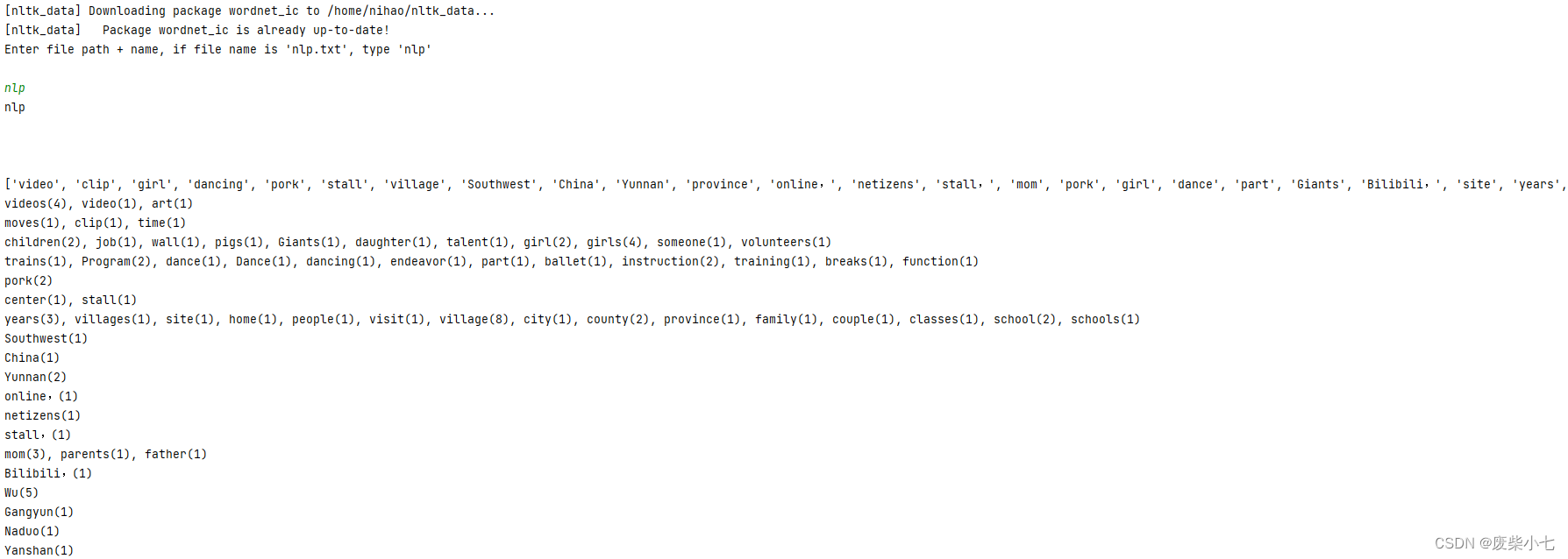import nltk
nltk.download('wordnet_ic')
from nltk.corpus import wordnet as wn
from nltk.corpus import wordnet_ic
threshold = 0.6 # treshold for wup
jcnTreshold = 0.09 # jcn
pathTeshold = 0.1 # path
brown_ic = wordnet_ic.ic('ic-brown.dat') # load the brown corpus
lexical_chains = [] # empty list to hold all the chains
dictionary = {} # empty dictionart to hold the count of each word encountered
class Chain():
def __init__(self, words, senses, count=0):
self.words = set(words)
self.senses = set(senses)
dictionary[words[0]] = 1 # initialize counter
def addWord(self, word):
if (len(self.words.intersection([word])) > 0):
dictionary[word] += 1
else:
dictionary[word] = 1
self.words.add(word)
def addSense(self, sense):
self.senses.add(sense)
def getWords(self):
return self.words
def getSenses(self):
return self.getSenses
def incCount(self):
self.count += 1
def add_word(word):
maximum = 0
maxJCN = 0
flag = 0
for chain in lexical_chains: # for all chains that are present
for synset in wn.synsets(word): # for all synsets of current word
for sense in chain.senses: # for all senses of the current word in current element of the current chain
similarity = sense.wup_similarity(synset) # using wup_similarity
if (similarity >= maximum):
if similarity >= threshold:
# print word, synset, sense, sense.jcn_similarity(synset, brown_ic)
JCN = sense.jcn_similarity(synset, brown_ic) # using jcn_similarity
if JCN >= jcnTreshold:
if sense.path_similarity(synset) >= 0.2: # using path similarity
if JCN >= maxJCN:
maximum = similarity
maxJCN = JCN
maxChain = chain
flag = 1
if flag == 1:
maxChain.addWord(word)
maxChain.addSense(synset)
return
lexical_chains.append(Chain([word], wn.synsets(word)))
fileName = input("Enter file path + name, if file name is 'nlp.txt', type 'nlp' \n \n")
fileName += ".txt"
print("\n\n")
# fileName = "nlp.txt" #输入文件名
File = open(fileName) # open file
lines = File.read() # read all lines
#is_noun = lambda x: True if (pos == 'NN' or pos == 'NNP' or pos == 'NNS' or pos == 'NNPS') else False
nouns = [word for (word, pos) in nltk.pos_tag(nltk.word_tokenize(lines)) if (pos == 'NN' or pos == 'NNP' or pos == 'NNS' or pos == 'NNPS')] # extract all nouns
print(nouns)
#输出所以名词
#NN Noun, singular or mass 常用名词 单数形式
#NNS Noun, plural 常用名词 复数形式
#NNP Proper noun, singular 专有名词,单数形式
#NNPS Proper noun, plural 专有名词,复数形式
for word in nouns:
add_word(word)
# print all chains
for chain in lexical_chains:
#print(chain)
print(", ".join(str(word + "(" + str(dictionary[word]) + ")") for word in chain.getWords()))
from collections import Counter
result = dict(Counter(nouns))
print(result)
print ([key for key,value in result.items() if value > 1])
print ({key:value for key,value in result.items() if value > 1})
#输入文件名
#查找所有名词,并输出名词列表(有重复)
#源代码的词汇链
#聚合名词列表,并输出频率大于1的单词。























 1227
1227

 被折叠的 条评论
为什么被折叠?
被折叠的 条评论
为什么被折叠?








